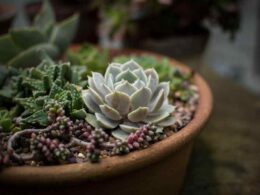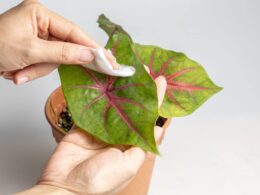What Is a Prayer Plant? Names, Origin, and Characteristics
Before we delve into prayer plant care, let’s introduce the species. The prayer plant (Maranta leuconeura) is a popular houseplant that gets its name from its unique habit of folding up its leaves at night, as if it were praying the evening vespers. It can sometimes be confused with the calathea, and it’s also known as:
- cathedral windows;
- herringbone plant;
- red prayer plant;
- rabbit tracks.
The prayer plant is native to Brazil, where it grows in the shady understory of the rainforest. It is a low-growing plant with smooth, oval-shaped leaves that are striped with shades of green, red, and white. The prayer plant is relatively easy to care for, making it a good choice for novice gardeners.
Prayer Plant Care – Soil and Fertilization
Prayer plants are native to the rainforests of Brazil, so they prefer moist and shady conditions indoors. The soil should be rich in organic matter and well-draining, as these plants are susceptible to root rot. When it comes to fertilization, prayer plants benefit from a monthly dose of all-purpose compost during the growing season.
If the leaves begin to yellow or the plant appears stunted, it may be an indication that the potting soil is lacking in nutrients. In this case, a half-strength solution of liquid fertilizer can be applied every two weeks. If you follow the basic prayer plant care tips, your plants will thrive and produce beautiful foliage that adds lushness and texture to any indoor space.
Prayer Plant Care – Watering and Humidity Requirements
Prayer plants thrive in moist soil and high humidity. They should be watered regularly, making sure that the soil does not dry out completely. A good rule of thumb is to water when the top 25% of the soil has dried out, and until water is coming out of the pot’s drainage holes.
Prayer plants are relatively tolerant of low humidity, but if the air is too dry, the leaves will begin to brown and curl. To raise the humidity around prayer plants, try grouping them together with other houseplants or setting them on a tray of pebbles filled with water. In addition, prayer plants benefit from occasional misting, which helps to keep the leaves healthy and free of dust.
Prayer Plant Care – Light Conditions
While prayer plant care is relatively easy, they do have some specific light requirements. Prayer plants need bright, indirect light in order to thrive. If they don’t get enough light, their leaves will become pale and their growth will be stunted.
However, if they get too much light, their leaves will develop brown scorch marks. So if you’re looking to add a prayer plant to your home, be sure to choose a spot that receives bright, indirect light.
Prayer Plant Care – Temperature Requirements
Prayer plants are tropical plants that prefer warm temperatures. They should be kept in a room that is between 65-85 degrees Fahrenheit during the day and above 55 degrees at night. If the temperature drops lower, your prayer plant will go into dormancy and its growth will slow down. It won’t do well in cold drafts, so keep it away from windows and doors during the winter.
Do You Need to Prune Prayer Plants?
Prayer plants benefit from regular pruning, as it helps to encourage new growth. After the plant has flowered, cut back the stems by a third to promote bushiness. You can also remove any yellow or brown leaves, as well as any leggy stems.
How to Propagate Prayer Plants?
Prayer plants are easily propagated by division or stem cuttings. To propagate by division, simply remove the plant from its pot and carefully divide the rootball into two or three sections. Replant each section in its own pot filled with moist, well-draining soil.
To propagate prayer plants from stem cuttings, cut a four-inch section from the tip of a stem that has at least two leaves. Remove the lower leaves and dip the cutting in rooting hormone. Plant the cutting in moist, well-draining soil and keep it warm and humid until new growth appears.
How Often Should You Repot Prayer Plants?
These indoor plants should be repotted every two to three years, or when they become pot-bound. When repotting prayer plants, be sure to use a pot that is only one size larger than the current one. Choose a pot that has drainage holes and is filled with moist, well-draining soil.
Common Problems with Prayer Plants
Prayer plants are relatively easy to care for, but there are a few common problems that you may encounter.
- Browning or yellowing leaves. This can be caused by too much direct sunlight, low humidity, or dry air. Make sure to increase watering and misting if this occurs. It might also have to do with chlorine and fluoride in your tap water.
- Pest problems. Aphids, mealybugs, and spider mites are all attracted to prayer plants. These pests can cause the leaves to yellow and curl, so be sure to check your plant regularly for signs of infestation.
- Root rot and fungal diseases. These problems are usually caused by too much water or damp conditions. Be sure to only water your prayer plant when the soil is dry to the touch.
Prayer Plant Toxicity
Prayer plants are considered to be toxic to cats and dogs. If your pet ingests a bit of a prayer plant, they may experience vomiting, diarrhea, and drooling. In that case, contact your veterinarian immediately.
Prepared to Care for a Prayer Plant?
Now that you know all about prayer plant care, it’s time to add one of these beautiful plants to your home. With a bit of attention, your prayer plant will thrive and bring you enjoyment for years to come!
Do you have a prayer plant in your home? Share your tips for care in the comments below!



















